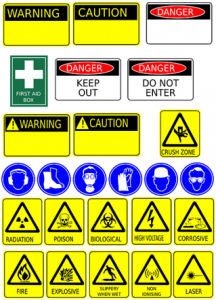Safety and DIY: A Real Life Guide
This entry was posted on Oct 29, 2014 by speedy-bedIf you’ve ever taken the time to read the instruction manual on any of your tools then you’ll have probably noticed, and then promptly skipped, the safety section. That’s because you know that you’re supposed to keep body parts away from sharp bits and not sit there inhaling dust and fumes, it’s common sense.
This doesn’t mean that safety is unimportant, but realistically who is going to put a mask on for putting emulsion on the walls? Some safety measures these days don’t seem practical, so if you’re looking for a real life safety guide to DIY then this is it:
Know the Tools
The biggest cause for DIY accidents is when people are using the wrong tools or simply don’t know how to properly use the tools they have. Don’t try to hammer a nail in using a 16lb mini sledge or try to cut copper piping with a tenon saw – this is where accidents happen. Ensuring you have the right tool and know how to use them is essential, if you are unsure at any point then try to find a YouTube video.
Wear Safety Equipment
While there are very few times doing DIY that you would need a hard hat, basic equipment such as safety glasses, workman gloves and ventilation masks are often used. Make sure that you know when to use these items and ensure that you are – they are there to protect you from injury and can, literally, be lifesavers.
Clear the Area
A crowded work area can be extremely dangerous as you run the risk of tripping or losing items in the clutter. Before you start doing any work make sure that everything you need is close to hand and there is nothing on the floor that you can trip over. If you’re using power tools that need plugging in then make sure that the cord will reach as far as you need it without getting in the way. This also includes making sure that children and animals are not anywhere near your workspace.
Ventilate the Area
If you’re doing anything that creates fumes or dust then you need to make sure that you have the windows and doors opened to ventilate the room. In close spaces it will also be beneficial to wear a mask to prevent the fumes or dusts from affecting you, this supposed to be done everywhere but it is largely a judgement call on your part but it can help prevent damage to your lungs.
Safe Ladder Use
You’d be surprised by just how many people incorrectly use ladders and end up injuring themselves or others because of it. Make sure that you always place the ladder on an even surface and not at a shallow angle without proper support. Instead of wildly leading over to reach the next bit you’re going to work on – get off and move the ladder, a little bit of effort and a minute of your time can prevent nasty injuries.
Leave it to the Pros
Knowing your limits is essential. If you don’t think you can do something then it will be cheaper in the long run to hire a professional and do it right, rather than pay someone to fix your mess. Certain tasks such as working with gas or messing with the mains electricity need to be left to certified professionals.
Take Your Time
When you’re in a rush you try to take shortcuts and don’t properly put things away, this is when things can get pretty sketch and you end up getting hurt. Make sure you allocate yourself plenty of time to carry out the task and do everything carefully and properly. Like the measure twice, cut once rule with DIY you need to plan twice and do once to maximise efficiency and ensure the job gets done right.

